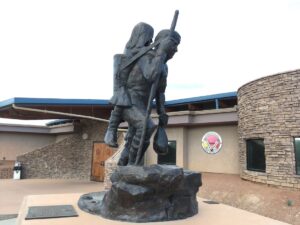One of the greatest benefits of living in the Verde Valley is that it’s a place of intense beauty. Throughout my life, I have been overcome by the landscape and moved to tears. My grandfather, Ned Russell, served as Chairman of the Yavapai-Apache Nation and was a respected elder of our tribe. For several decades due to his work, he lived outside of Arizona. He related to me that when he finally moved back to the valley after retiring, he stopped at the scenic overlook south of Munds Park on I-17. When he looked out over the valley, with the Red Rocks and Oak Creek Canyon in the foreground and Mingus Mountain and Jerome at the far end, his childhood languages—Yavapai and Apache—came flooding back to him. I similarly lived on the East Coast for several years, making the annual drive back to my ancestral lands and stopping at the same scenic overlook, each time experiencing an almost instantaneous reconnection to my homelands. I share these experiences to illustrate the point that as the Indigenous peoples of the Verde Valley, our connection to the land goes beyond mere appreciation, even awe, for its beauty. Our language, culture, history, and very sense of being are connected to it. Speaking both as an historian and Yavapai-Apache, while I can understand the love and appreciation that my non-Indigenous neighbors have for this land, it can also be frustrating how little they know of our deep historical, cultural, and spiritual ties to this place. Even more frustrating, we often face barriers or inconveniences in our access to these places.
Put in the simplest of terms: we are the land, and the land is us. Cultural protocols allow me to share only general information about the stories connected to our sacred sites, but I can share a few general ideas, as well as some more recent history that will likely be new information to many readers. In our creation story, First Woman came out of the earth at the place now called Montezuma Well, and our people descended from her. We did not migrate from somewhere else, nor were placed here; we came from the land itself. Furthermore, after a major flood receded, she came to safely rest in what is today Boynton Canyon. Thus, we have been in the Verde Valley since time immemorial. Imagine my dismay at being severely scolded by a park ranger at the Well for going “off-trail” to make an offering to my ancestors. I was literally told I had no right to properly respect the place where life began for our people. Or consider how it feels knowing that Boynton Canyon, the place where our ancestors found safety and support in the beginning of time, is owned by a combination of national forest and private resort. These are our most sacred spaces, and while we are not barred from accessing them, we do not have exclusive control over them.
Similarly, there are constant reminders of our more recent history of violence and dispossession. The area around the Yavapai College Verde Valley Campus in Clarkdale is known as Haskell Springs. It rests in the foothills of Mingus Mountain and has beautiful views of the valley. What many don’t know is that the area was the headquarters of the Rio Verde Reserve, where Yavapai-Apaches were placed after being rounded up by the U.S. Army in the early 1870s. Or consider Indian Gardens in Oak Creek Canyon, named for the garden plots of our people that, upon our removal from the Verde Valley in 1875, were occupied by homesteaders who plucked the fruits and vegetables we had been growing before being out. Or consider the galling reminder every time we drive on General Crook Trail (Highway 260), named after the army officer who orchestrated the violent campaigns against our people, and then went back on his promise that we could remain on our original reservation in the Verde Valley, from which we were removed in 1875 and force-marched to San Carlos. Or the next time you drive on I-17 and pass signs for Skull Valley and Bloody Basin, know that those names refer to our skulls and our blood. In other words, please remember that the stunning beauty of this place has undercurrents perhaps few understand but are clear to Yavapai-Apaches.
I hope you’ll forgive my negative tone, but these are things that need to be said and understood. On a more positive note, the sacred stories of our ancestral sites are still alive. I have listened to them and recounted them. They bring me joy and remind me that I am the land, and the land is me. As of this writing the Yavapai-Apache Nation is involved in a land exchange that would add several thousand acres to our land base, which was completely taken from us in the 1870s, with only tiny bits later set aside for us since the early 1900s. This is what we need as Yavapai-Apaches; the land is us and we are the land.
Disclaimer: I speak only for myself as a citizen of the Yavapai-Apache Nation and as a historian, not in any official capacity as a representative of the Yavapai-Apache Nation.
Friends of the Forest contributes a monthly submission for Serving Sedona in the Sedona Red Rock News.. The month’s guest contributor is Maurice Crandall, PhD, Arizona State University.
